Janet Hulstrand's Blog, page 16
November 13, 2018
Remembering War, Looking Toward Peace: Armistice Day, 2018
Essoyes, Armistice Day 2018
“…Francaises, Francais, dans chacune de nos villes et dans chacun de nos villages, Francaises et Francais de toutes générations et de tous horizons, nous voila rassemblés en ce 11 novembre. Pour commémorer la victoire. Mais aussi pour célébrer la paix…” Emmanuel Macron, président de la République
It was an emotionally intense week in France last week as the country marked the 100th year anniversary of the end of the First World War. The week began with President Emmanuel Macron taking to the road for a five-day trip through the killing fields of the war, following an itinerary that would bring him to a number of memorial sites. Some very poignant moments of the president’s visits to these sites were shared with the public on television, including his visit to the Ossuary of Douaumont, which contains the remains of 130,000 unidentified soldiers, both French and German, who perished during “the hell of Verdun.”
All along the way le president de la République (which is how the French people refer to their president, almost always) took the opportunity to talk to ordinary people in the towns and villages near these sites, and to confront their often fairly angry questions, in what is known in French as a bain de foul (a bath in the crowd), which means, basically, diving into a crowd of people and engaging with them in direct conversation. The thing that was the most extraordinary about this to me as an American watching is that a) the president does this at all (that he can take such a risk, among other things); b) that the exchanges were as substantive and as long as they were; and c) that the media covered it so well. The first time I observed Macron in a bain de foule was during his presidential campaign in 2017, when he went directly into a crowd of very angry workers at a Whirlpool factory in Amiens that was about to be closed. I was so impressed with the way he listened to them; the way he got them eventually to listen to him as well; and both the length and the substantive nature of the conversations he had with these workers. And the media covered it–close up and nonstop, with microphones placed so that listeners could hear every word–for nearly an hour. No cutting away for commercial breaks, either!
Of course the conversations this week were not exactly pleasant, but they were really interesting: workers, retirees, “ordinary citizens,” challenging their president on a number of issues, from the rising cost of gasoline and the falling level of purchasing power (pouvoir d’achat) to various issues of taxation and other policy matters. The citizens asked him some very pointed questions, and he gave them substantive answers which were not (however) necessarily accepted by them, and when they were accepted (often grudgingly, or skeptically), it was not without a great deal of substantive dialogue back and forth first.
None of this would be able to happen in the United States for a variety of reasons, and I found myself feeling wistfully envious about that. It is an aspect of democracy in action that we, who think ourselves as being such a paragon of democracy, just do not have access to.
Meanwhile, a great controversy erupted over the fact that the marshals of France who had presided over “the Great War” (including the infamous Marechal Pétain– who was a hero of World War I, but who was a Nazi collaborator, therefore a traitor, in World War II) would be honored at a ceremony at Les Invalides toward the end of the week. A vivid debate arose about how the legacy of such a person should be treated by historians and indeed by the general public. The bitterness of both World Wars is still acutely felt in France, the wounds are not yet healed.


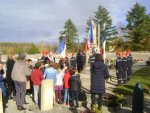
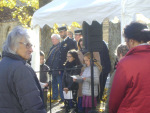
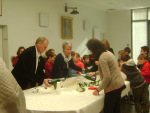
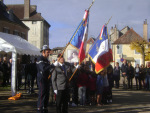
Armistice Day (November 11) is always an important day in France, always solemnly and respectfully marked in every little French village and town. I have written about how it is honored in my little village before. Every year the church bells ring out at exactly 11:00. Every year the names of every single one of the war dead whose names are carved on our village’s war memorial are read, as the members of the volunteer firefighter/EMS corps shout out Mort pour la France! after each name. Every year there is a proclamation read aloud, reminding the French people what is being commemorated, how many people suffered and died (noting that it was certainly not only Frenchmen), and why. In past years this address has been from the Minister of the Armed Forces to the people. This year it was from le president de la Republique, and I have quoted from it briefly above. As for the whole of the special events surrounding this centenary, the emphasis in this message to the people of France was not on victory in war, but on its enduring and devastating effects; and on the fervent hope, and the will, to construct a lasting peace.
As the hour of 11 am struck, reenacting the moment when peace finally came to France in 1918 after four dreadful years of war, the church bells began to ring out with deep, rich, joyous tones: in our village square, in Paris, and indeed in every little village and town in France. Then the volunteer firefighters marched through the streets of the village, leading the way to the war memorial for the reading of the names. This year the children of the village were quite involved in the ceremony: several of them read aloud letters that had been written by soldiers in the trenches back home to their loved ones. One letter was quite openly bitter about the old men who sat in offices directing a conflict in which so many young men had died–needlessly. Then the children led the attendees in singing la Marseillaise; and from there we all proceeded to the cemetery where flowers were laid at the memorial in the part of the cemetery dedicated to the war dead.
Then it was back to the village square and the closing of the ceremony, after which the mayor opened the doors of the village hall and invited everyone in for a coupe de champagne. (As usual paté a choux and cookies were also served, to make sure no one’s stomach was too empty to handle the champagne.) The mayor himself, and his wife, poured the champagne and served it to those in attendance: to me a touching and fitting symbol of the meaning of the words “public service.”
Meanwhile, in Paris, more than 60 world leaders had gathered to join President Macron in marking the end of the commemoration. One particularly moving photograph shows them approaching the Arc de Triomphe in the rain, side by side: some commentators noticed that after a weekend full of the careful observance of many important details of protocol (who arrived first, who arrived last, who was seated where, and so on), for these few minutes protocol seemed to fall by the wayside, as these leaders simply walked together in a somewhat spontaneous and informal show of equality, dignity, solemnity–walking side by side together we all hope!–toward peace.
One world leader was notably missing from this part of the commemoration. (He declined to travel with the other leaders, choosing to get to the ceremony instead in his limousine, with blinds drawn). He was also absent from quite a few other important parts of the weekend and the days following as well, and he quite notably departed from France before the Peace conference began on Sunday afternoon.
That president behaved for the two days he was in France like a petulant, spoiled child, and though everyone, especially President Macron, did their best to maintain a stoic dignity in the face of it, and attempted to continue to bridge differences and promote constructive dialogue, it wasn’t easy.
I am often surprised at the lengths to which the French political analysts and commentators on the TV station I watch go to, to be diplomatic in their remarks about a most undiplomatic man. This time they remained measured and dignified in their commentary, but they were clear about what they noticed overall: that the president of France had hosted an important commemoration that had been very carefully planned to be a series of events that would focus on peace; on European unity; and on multilateralism; and that this ungracious visitor did the best he could to turn it into a celebration of militarism, nationalism, and unilateralism.
I guess that is all I am going to say about that. It was a sorry display, and an embarrassment to many Americans abroad.
Janet Hulstrand is a writer, editor, writing coach, and teacher of writing and of literature who divid es her time between the U.S. and France. She leads writing workshops in Essoyes, a village in the Champagne region, and teaches “Paris: A Literary Adventure” for the City University of New York each summer. She is currently working on two books: A Long Way from Iowa, a literary memoir; and Demystifying the French, a cultural guide to living and traveling in France.
October 26, 2018
An interview with Lin Wenjie, recipient of the Bourse Renoir
Opening at the Maison Renoir for an exhibition of the paintings of Lin Wenjie.
In 2016 Lin Wenjie was awarded the Bourse Renoir by the Association Renoir , which was established in 1988 by Claude Renoir, a grandson of Pierre-Auguste Renoir. This award includes a generous grant; a place to live and work in Essoyes; and an exhibition sponsored by the association. Wenjie is the first recipient of the award to also be honored with an exhibition of her paintings in the Maison Renoir , which was recently renovated and opened to the public. Her paintings are currently on display there, and they will be there through November 25. Wenjie recently took the time to answer my questions about her life and her work, in French, via email. The French version of the interview follows.
Janet Hulstrand: Where did you grow up, when did you know you wanted to be an artist, and what was the path that brought you from China to France?
Lin Wenjie: I grew up in Canton, in China. I did my studies in Canton through the junior high level, and then I went to the high school in Beijing that is connected with the Central Academy of Fine Arts, and studied fine arts. The idea of being an artist came to me during my high school years. That’s when I got to know a lot of artists, I learned about different artistic movements, the history of art, and I began to see that it was art that really interested me. Before I went to Beijing, I didn’t really know what I wanted to do. I was very attracted to this high school, which is connected with the most well-known and prestigious school of its kind in China. After I finished my studies in fine arts I had been in Beijing for eight years, and I wanted to go somewhere else. I chose France because it is an important country for art, and especially for painting.
[image error]
“Noon.” 2018 Copyright Lin Wenjie. Photo by Christian Monnet.
When did you first become familiar with the works of Renoir? And how does it feel to have your paintings now hanging in the same room that is used to display the work of Renoir and other famous painters during the summer months?
I learned about Renoir’s work when I was in high school. The method that we were taught for studying the effects of light came from Impressionism. We studied the works of the masters of Impressionism a lot. It’s a huge honor for me to be able to show my paintings in Renoir’s home!
What did you like best about your time in Essoyes?
I love the peaceful atmosphere in Essoyes.
[image error]
“Twins” 2017. Copyright Lin Wenjie. Photo by Christian Monnet.
What do you think most people don’t understand about painting, or about the work of painters, that is important for them to understand?
I don’t know. Maybe that painters are not only seeking to make pictorial images, it’s something beyond that. I don’t know if it’s really so important for people to understand painting, it’s more that it’s interesting to try to see beyond just the images. People can understand and interpret paintings in their own way, drawing on their own life experiences.
What is the most important thing for you about being an artist? That is, how would you describe your main goal, or goals, in creating your work?
The most important thing for me is that one be sincere in approaching each creation. I hope that I can offer viewers a positive vision of life through my painting.
[image error]
“Palais des Papes” 2018. Copyright Lin Wenjie. Photo by Christian Monnet.
What are you working on now?
I am working on a series of paintings about Chinese opera. This past summer I accompanied a Chinese theater troupe to the arts festival in Avignon. I will be doing several paintings on this subject.
Janet Hulstrand is a writer, editor, writing coach, and teacher of writing and of literature who divid es her time between the U.S. and France. She leads writing workshops in Essoyes, a village in the Champagne region, and teaches “Paris: A Literary Adventure” for the City University of New York each summer. She is currently working on two books: A Long Way from Iowa, a literary memoir; and Demystifying the French, a cultural guide to living and traveling in France.
En 2016, Lin Wenjie a reçu la Bourse Renoir de l’Association Renoir, créée en 1988 par Claude Renoir, petit-fils de Pierre-Auguste Renoir. Ce prix comprend une bourse généreuse; un domicile et un atelier à Essoyes; et une exposition parrainée par l’association. Wenjie est la première lauréate de ce prix à être honorée par une exposition de ses peintures à la Maison Renoir, récemment rénovée et ouverte au public. Ses peintures sont actuellement exposées là-bas et elles y resteront jusqu’au 25 novembre. Wenjie a récemment pris le temps de répondre à mes questions sur sa vie et son travail, en français, par courrier électronique.
Janet Hulstrand: Ou est-ce que vous êtes grandi? Comment et quand est-ce que vous avez su que vous voudriez être artiste?
Lin Wenjie: J’ai grandi à Canton en Chine. J’ai fait mes études à Canton jusqu’au niveau collège et je suis allée dans un lycée attaché aux Beaux-Arts de Beijing et ensuite aux Beaux-Arts (Central Academy of Fine Art). L’idée de devenir artiste est venue pendant mes études au lycée. C’est là où j’ai découvert plein d’artistes, différents courants artistiques, l’histoire de l’art, et j’ai commencé à voir que c’était l’art qui m’intéressait. Avant aller à Beijing, je ne savais pas vraiment ce que j’allais faire. J’avais été prise par ce lycée et j’avais decidé d’aller à Beijing. (Les Beaux-arts de Beijing est l’école la plus connue et la plus prestigieuse dans son genre en Chine. Ce lycée est aussi connu parce que ce sont presque les mêmes enseignants qu’aux Beaux-arts.) Après avoir fini les Beaux-arts cela faisait huit ans que j’étais à Beijing et je voulais aller voir ailleurs. J’ai choisi la France parce que c’est un pays important pour l’art et particulièrement pour la peinture.
Quand est-ce que vous avez prit connaissance de l’art de Renoir? Et qu’est-ce que vous en pensez, d’avoir vos peintures dans la même salle ou les peintures des artistes très célèbres soient montrés pendant l’été?
J’ai abordé l’art de Renoir quand j’étais au lycée. La manière dont on nous enseignait l’étude de la lumière se basait sur l’impressionnisme. Nous regardions beaucoup d’œuvres de maîtres de l’impressionnisme. C’est un immense honneur pour moi de pouvoir exposer dans sa maison.
Qu’est-ce que vous aimez le mieux ici a Essoyes?
J’ai beaucoup aimé l’ambiance paisible à Essoyes.
[image error]
“Maillot a pois” 2016. Copyright Lin Wenjie. Photo par Christian Monnet.
Qu’est-ce que vous pensez que la plupart de gens ne comprend pas en ce qui concerne la peinture, en ce qui concerne le travail des peintres, que c’est important qu’ils comprennent?
Je ne sais pas vraiment. Peut-être que ce que les peintres cherchent, ce ne sont pas que des images picturales, c’est aussi quelque chose au-delà des images. Je ne dirais pas que c’est important que les gens comprennent la peinture, mais plutôt que c’est intéressant d’essayer de voir ces choses au-delà des images. Les gens peuvent comprendre et interpréter les peintures à leur façon et avec leur expérience de vie.
Qu’est-ce que c’est la chose la plus importante pour vous, comme artiste? C’est a dire, comment est-ce que vous décrirez comme votre but, vos buts, en créant votre oeuvre?
La chose la plus importante est d’être sincère devant chaque création. J’espère pouvoir proposer une vision positive sur la vie dans ma peinture.
Quelles sont vos projets courants?
Mon sujet du moment est l’opéra chinois. L’été passé, j’ai accompagné une troupe de théâtre chinoise au festival d’Avignon. Je ferai plusieurs peintures sur ce sujet.
Janet Hulstrand est une écrivaine, rédactrice, et professeure d’écriture et de littérature qui partage son temps entre les États-Unis et la France. Elle anime des ateliers d’écriture à Essoyes, un village champenois, et enseigne chaque été “Paris: A Literary Adventure” pour la City University de New York. Elle travaille actuellement sur deux livres: “A Long Way from Iowa,” un mémoire littéraire; et “Demystifying the French,” un guide culturel pour les étrangers, et les voyageurs en France.
October 17, 2018
It’s been an exciting week in Essoyes…
[image error]
First of all, it has been so lovely here, an “Indian summer” that doesn’t end! (This is probably not really a good thing, globally speaking. But we may as well enjoy it from day to day, as glorious October day follows glorious October day…)
Most of the time my life here is pretty quiet, and that is a large part of the reason I love it so much. In Essoyes I have found a place where peaceful solitude, and the ability to concentrate on my work is fairly easy to achieve.
But last week was different.
[image error]
Headline: “A grandson of President Truman in Essoyes”
First of all, Essoyes was honored with a visit to the village by some very special American guests of honor. Clifton Truman Daniel, grandson of President Harry Truman, and his wife were here, along with Marie-France Ménage-Small and her husband, proprietors of the Chateau de Montigny sur Aube, which is not far from here in Burgundy’s lovely Côte d’Or. The Daniels had been invited to the chateau to attend the inaugural ceremony of the Harry Truman Grove, and while they were in this part of France they also visited the Memorial Charles de Gaulle in Colombey-les-deux-Eglises and the restored Renoir home in Essoyes.
I probably should back up, just briefly, 100 years, to explain why there is a Harry Truman Grove at a chateau here in the heart of France: the reason is because in 1918, as a member of a battalion of American soldiers who were being trained in the use of a 75 millimeter cannon, Harry Truman spent several months there.
Most of the time when French people express their gratitude to the United States for our involvement in allied military action, it is about World War II. But this is an instance in which it is our involvement in World War I that was and is being recognized and honored in a very elaborate and wonderful way by our French friends. And so, on Thursday, October 11, a gathering of French and American dignitaries gathered to honor this joint history, and to mark the (near) centenary of the end of the First World War.
I was not able to attend that event, but as one of only two Americans in Essoyes, I was honored to be invited by Mayor Alain Cintrat to attend a ceremony the following day, right here in Essoyes, to help welcome these very special visitors to our town. The simple reception that the Mayor had arranged for them was perfect in every detail: fresh flowers adorned a table that featured a centerpiece with the French and American flags; the Mayor gave a very touching speech welcoming our visitors, and my friend Desirée (the other American essoyenne), who had been asked to translate the speech into English, delivered it in English after the Mayor had given his welcome in French. Desirée has kindly shared the text with me so that I could quote from it here:
“As an artillery officer, your grandfather spent several months in Montigny. Arriving as a lieutenant, he left with the grade of captain after having followed an intense military training. It was an important period in his life. He demonstrated his leadership qualities, and his discovery of Europe bestowed on him a new vision of Europe. He may not have been conscious of it, but his wish to serve his country at the highest level may have taken shape on French territory, in Montigny sur Aube… You came here to visit the Renoir family home: the notion of family is important to the Renoir history. It was Renoir’s wife, a native of Essoyes, who introduced him to the village. At first a bit reluctant, he ended up adopting Essoyes and Essoyens. He appreciated the light, the calm, the serenity favorable to artistic creation. For thirty years he came here every year…Jean Renoir wrote that “The most beautiful years of my life were spent in Essoyes: for me there is not another village in the world that can compare.” This connection of the Renoir family with this village is so strong that the whole family is buried here. None of them passed away in Essoyes, but all had chosen this land as their final home…If there is a relationship between the Renoir family and Essoyes, there is also one with the Renoir family and the USA. Indeed, a number of Renoir family members live or have lived there: some have become American citizens.”
The Mayor concluded his remarks by thanking Mr. and Mrs. Daniel for their visit, and Mme. Ménage-Small for her role in initiating and hosting such a wonderful, collaborative endeavor. Then, after he had presented Mr. Daniel with a special commemorative medallion from the village of Essoyes, the guests were served exquisitely presented and delicious petit fours prepared by one of our local traiteurs, along with–of course!–champagne.
Mme. Ménage-Small had invited the guests in attendance that day to visit the chateau on the weekend, to see the exhibition that had been put together, and even the very cannon that had been used for training the American troops, which was on loan for the weekend only. And so I went there with friends on Saturday, another gloriously beautiful (and summery!) day. I will write another time about the charms of the Chateau de Montigny-sur-Aube: for now I will just present a few of the photos I took to show what a great place it is to visit!

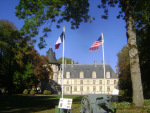



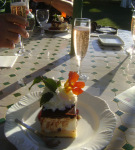
One thing that I particularly love and admire about the civic leadership in Essoyes is that in addition to preserving and celebrating the legacy of past artists who have lived here, special effort is given to providing support to young contemporary artists. Last night another special event took place in the Maison Renoir: the opening of an exhibition of paintings which will be on display there through November 25. The artist is Lin Wenjie, who was the recipient of the 2016 Bourse Renoir, an annual fellowship awarded to a young artist by the Association Renoir. So now Wenjie has the honor of having her work hang in the room specially designated for the display of original works of art, the same room that the Renoir family and their guests dined in once upon a time, the same room in which Renoir’s own paintings are sometimes displayed on loan from French museums. Quite an honor for a young artist!
[image error]
An art opening at the Maison Renoir on a lovely October evening.
But that wasn’t even all of the excitement for me this month so far. I did a whirlwind trip to Paris on October 9 to meet one of my former Politics & Prose students at Adrian Leeds’s Après-Midi meet-up, and to hear Cara Black talk about her latest mystery. It happened to be the day of a national rail strike, which introduced a bit of unpredictability into the question of whether or not this trip would be successful and I would be able to complete it as planned. But, although delayed a bit, I got there on time for the event: and I got back home again too in the same day, lucky me!
Due to an interlocking set of poorly planned details, I was accidentally thrust into the situation of having nothing to read for a few hours, something which normally would drive me crazy. I decided to not let it get to me this time, but rather to use the forced downtime to enjoy quietly and carefully observing the world around me, first at the train station in Vendeuvre-sur-Barse, then meditatively viewing the beauty of the passing landscape between there and Paris. It is always a pleasure to hear Cara Black speak; it was wonderful to be able to see my friend while she was in Paris; and the whole idea that I live close enough to Paris that I can do this–zip into and back out of that wonderful city, all inside of one perfect autumn day (even on the day of a national rail strike!)–and then find myself back in the peacefulness of the champenois countryside, is just one of the very best things about my current life.
Now it’s back to to that quiet country life. When I need a break from my writing, I’ll be raking leaves here on the edge of the forest, wearing my brightly colored hat: a signal to any nearby hunters that I am not a deer!
[image error]
And that is the news from Essoyes, for now….stay tuned for more…
Janet Hulstrand is a writer, editor, writing coach, and teacher of writing and of literature who divid es her time between the U.S. and France. She leads writing workshops in Essoyes, a village in the Champagne region, and teaches “Paris: A Literary Adventure” for the City University of New York each summer. She is currently working on two books: A Long Way from Iowa, a literary memoir; and Demystifying the French, a cultural guide to living and traveling in France.
September 30, 2018
Here comes autumn…
Autumn in Essoyes
It has been such a beautiful month of September in northern France this year!
And it is a busy time too. Almost immediately after the big trucks hauling grapes had stopped making their several-times-a-day runs from the vineyards to the pressoir in Essoyes during the vendange, they were replaced by big trucks hauling loads of wood out of the forest, bringing people their fuel for the winter. And so that sweet smell of grape juice that lingers in the air after the vendange has been replaced with the scent of freshly-cut wood…

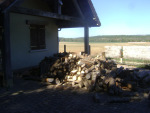

My firewood was delivered this week. The first time I had to arrange for a delivery of wood, a couple of years ago, I had a lot to learn, as i wrote about here. This time I was much more well prepared, but I still gave myself a little refresher course from the helpful cowboy (Cody) at WranglerStar.com before I began stacking the wood. The job went much more quickly this time than the first time, partly because I only ordered half as much wood this time, and partly because I knew what I was doing.
It’s hard work, stacking wood, and I got pretty stiff and sore by the end of the day, but I managed to make some very neat piles, much more well organized than my first time around, in record time. It’s hard work, but it’s an enjoyable task too, and a nice change of pace for a writer. The weather was gorgeous, sunny and warm, with a slight breeze: and since every time I looked up from my work what I saw is the view at the top of this post–how bad can that be, really?! (Not. Bad. At All!)
It’s also a good feeling to know that I’m ready for winter weather when it comes. And the prequels are already here: although the afternoons have been sunny and warm, even summery, the mornings and evenings are quite “brisk,” as they might say in my home state of Minnesota. (Though they wouldn’t say about it the weather we’re having here right now. Not yet! Not Minnesotans… 
September 9, 2018
Report from Essoyes: Les Vendanges 2018
Pinot Noir grapes ready to be crushed and begin the long, complicated process of being turned into champagne.
“It’s been a good year!!” my friend Béthsabée announced, when I stopped by to say hello and ask how the vendange was going this year. “It’s been a very good year,” she added. “It’s the kind of year we’ve been waiting for for 10 years.”
This is a huge relief. The last few years have been difficult ones for the vignerons in this area, due to a combination of late frosts following warm weather in the spring, and some violent hailstorms in the summer. Like all farmers, vignerons are at the mercy of the elements: it is a risky business. One more reason to admire, and be grateful to, those willing to take those risks and to produce the food we eat, and the wine we drink.
During the harvest, which usually lasts about 10 days, everything changes in this little town. Early in the morning the enjambeurs–tractors made specifically for working in vineyards, with “legs” that straddle the vines–start their engines and head into the hills. Usually by 7 am the pickers are in the fields, and they pick until at least 4 or 5 p.m. But that is just how long the pickers work: depending on the weather, sometimes the enjambeurs don’t make it back to their storage spots until nearly dark, around 8:30 pm at this time of year. Then, after that, the sounds of banging, crashing, and clanking as baskets of grapes are unloaded into the machines at the pressoir goes on well into the night, often til around 11 pm. I can hear this activity from across the field, and can see the bright lights blazing as the work continues. And this work goes on seven days a week until the crop is all in.
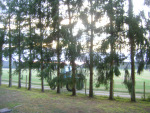
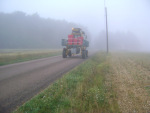



In addition to the very complicated process of harvesting and crushing the grapes, which I won’t go into here and now, there are many tangential complications to the harvest season as well, actually for everyone in the small towns where champagne is made. Last year when I saw that one of our bakeries was going to be closed for a few days prior to the vendange and I saw the baker walking his dog in the village square, I asked him if he was taking a few days of vacation. He laughed! (No, he was getting ready for the vendange.) Also last year, an organ concert scheduled to take place in the church was cancelled “due to the vendange” meaning, presumably, that since in the days prior to the vendange, pretty much everyone is busy preparing for the vendange; therefore, no one would be able to come to a concert. I also remember empty shelves in the stores at the end of the vendange, and that the butcher had run out of beef to grind when I asked for some to make my first chili of the season.
There are logistical complications, too, when the population of a small rural village suddenly expands for a period of 10 days. Thiis year the following sign was posted around town for everyone to see:
[image error]
“Because of the vendange, there will be a supplementary garbage collection this Friday, 31 August 2018. Thank you for putting your containers out on Thursday evening.”
This year the vendange began for most of the vignerons around here on or about August 27: quite early, but it has been quite early for the past few years. (When I participated in the vendange in 1978 it started in early October.) By September 7 it was over for everyone around here as far as I can tell. One of the signs of this was the huge trucks carrying baskets full of grapes that came barreling down the road that goes by our house fairly early on Friday afternoon. They were coming back from the vineyards, honking their horns in the manner of a wedding party, or perhaps a better analogy in this case would be to say in the manner of cowboys shouting “Yee-haw!” and “Yip-yip-yippee!!!”
Another sign that the harvest was over was that there were lots of grape pickers hanging out in the cafe and the kebab place on Friday afternoon when I went into town to mail a letter, at a time they would normally be up in the vines, still working hard.
A final clue was in the fact that a number of the vendengeurs who have been camped in the field between our house and the town during the vendange passed me, walking toward the pressoir, as I was walking home in the opposite direction. I assumed they were going to collect their pay. There was a festive feeling in the air and a spring in their step that made me feel enough esprit de corps that I overcame my habitual reserve and asked “C’est fini?” “C’est fini!” was the cheerful answer, as the person who responded to me nearly skipped on his way.
The first time I came to Essoyes, I came here as a vendengeur, along with two other American friends I had met in Paris. During that vendange, which was 40 years ago, the son of one of the two brothers we were working for was just a little boy. I don’t know if I really remember seeing him peeking out from behind his mother’s back as she prepared our meals in the kitchen, or whether I just like to imagine that I did. In any case, that little boy grew up to marry the daughter of another vigneron in the area, and I like to take the participants in my writing workshops to déguster le champagne at their establishment in nearby Fontette. This week they posted some lovely photographs of this year’s vendange, which you can see here. They’re wonderful photos, and they do a great job of showing the aspect of the harvest that is convivial, joyful, and conducted in a landscape of surpassing natural beauty. What doesn’t show through in these photos is what hard work it is: and that’s okay! But ever since I worked in the vines myself I have known that the people who do this work are working very hard indeed. And that there are many moments that require patience and fortitude, especially when the weather is challenging, whether it’s cold and rainy, or blazingly hot. I think of them with empathy every time the weather (always very changeable in Champagne, even within a single day) shifts toward one of those two extremes during the vendange.
And so for another year, this part of the process draws to a close, though the work goes on all year. In this part of Champagne there is a tradition called le chien de vendange which is a celebration of the end of the harvest. (There are two vague theories as to the meaning behind the term faire le chien: one has to do with the position of the star Sirius (known as “the dog star”) at the end of summer. The other, as best I have been able to gather, is more or less akin to our phrase “working like a dog,” certainly an apt analogy for the effort involved in the grape harvest.) I have been pleased and honored to be invited to join my friends Béthsabée and Léa at their “chien” for the past few years, where they graciously serve champagne–and of course, as always in France, also good food–to their colleagues, employees, clients, and friends. This year Léa’s 12-year-old sons were busy helping to welcome guests, making the rounds to faire la bise, and serving champagne and aperitifs.

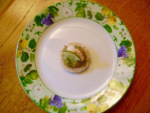

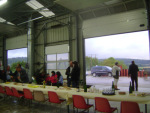

One more interesting “detail” to share with you in closing this post. Everyone I’ve talked to so far has been very happy with this year’s harvest because it has not only made up for the several not very good years preceding it, but because the harvest was top quality, and plentiful enough to allow the vignerons to replace most of the low quality harvest of 2017, and to store away reserves that will be helpful if next year is not as good.
And get this: in l’Aube, when there is a very good year, the “wealth” is shared. Which means that the vignerons who suffered damage this year in a very destructive hailstorm in late May were given grapes by their neighbors who had escaped damage. Did you hear that? I said they were given grapes by their neighbors.
Ponder that concept for a while, and know that the world is full of better ways to do things…
Janet Hulstrand is a writer, editor, writing coach, and teacher of writing and of literature who divid es her time between the U.S. and France. She leads writing workshops in Essoyes, a village in the Champagne region, and teaches “Paris: A Literary Adventure” for the City University of New York each summer. She is currently working on two books: A Long Way from Iowa, a literary memoir; and Demystifying the French, a cultural guide to living and traveling in France.
August 20, 2018
Back Home in Essoyes…
[image error]
“Happiness is the settling of the soul into its most appropriate spot.”
That is the quote, attributed to Aristotle, that came to me when I was asked where my sacred place is, and why I chose it.
This was in answer to one of several questions I was asked, to accompany an excerpt from the memoir I have been working on for some time that was published last year in a collection of essays called The Pilgrimage Chronicles: Embrace the Quest.
And even though the excerpt that was published in The Pilgrimage Chronicles is about my experiences in a little town in Iowa where I had gone to to pursue my quest–seeking to understand my grandmother’s inner life–nonetheless, when I was asked how I chose my “sacred place,” it was Essoyes that came instantly to my mind.
I had never really thought about whether or not I had a sacred place before being asked this question; but indeed Essoyes is the one place in this world where over the past couple of years I have felt my soul settling into its most appropriate spot. And there is a deep contentment that goes along with having found that place at last.
There are a few other places in the world that I love deeply and can feel very happy in–places all over Minnesota, New York City (especially Brooklyn), Paris.
But I wouldn’t call any of them my sacred place, and I have never felt quite so completely right in any of them, never quite so completely my fullest, truest, best self–as I have in this place, a little rural village in Champagne, not too far from Paris, where all the fundamental parts of myself can be nourished and inspired.
I suppose it should not, then, have been surprising to me how unsettling it could be to be away from here this summer for a longer time than I wanted to be. I spent the summer doing things I needed to do and seeing people I enjoyed seeing very much. I had a good, rich, enjoyable, productive time. Most of the time in the three months I was away was spent in Washington DC and Minnesota, with side trips to New York and Ohio to see my sons, and two nice long road trips that allowed me to reconnect with family and friends I hadn’t been able to spend very much time with in recent years.
But I didn’t feel I was at home this time, not even in Minnesota. I love Minnesota, deeply, profoundly; and when people ask me where I am from, I always say Minnesota, because that is the truth. I like being there, I like it a lot, and I wish I could spend more time there; but there is a reason that when I left there at the age of 25 to travel in Europe, I never really lived there again. I didn’t know at the time that I was leaving for good, but as it turned out, I was.
And so here I am, back home in Essoyes. Getting back to work on various projects. Sinking into the rhythm of this lovely place once again. Taking long walks at sunset across a field that is sometimes–like last night–wonderfully quiet and peaceful. Just me and the fields and the sunset, and the songs of the birds, affording me the opportunity to be embraced and renewed by a beautiful and rare–even for here–complete and total solitude.
There is also, of course, pleasure in the social and cultural life of the village. An exposition of works of art depicting Renoir and his children will be on display at Du Côté des Renoir through September 30. Last week there was an organ and choir concert of Polish musicians performing in the church. And soon the vendange, the annual harvesting of the grapes, will begin. When it does, for a couple of weeks everything here will be focused on that. There will be more to come about that, probably, in my next post.
This morning I was awakened by the bells that ring out from the churches at both Essoyes and Loches-sur-Ource, the nearest village to us. There is a lovely asymmetry in the ringing of these bells that I enjoy: that is, the bells ring almost at the same time, but not quite. They are a couple of minutes apart: so which village has it right? Essoyes or Loches? What time is it, really?
It doesn’t matter, at least it doesn’t matter to me. What matters to me is that I get the chance to hear both of them; that there is a sufficient pause between the two so that one can really enjoy both of them, rather than feel that they are competing with each other; and that they are both lovely, one a little bit closer to me, the other farther away.
One day, maybe, I will write an essay about how much I love the ringing of church bells, and why I do. For now I will just say that I think there is something primal about marking time in this way, something that makes me feel connected to earth and sky, field and village, the sacred and the mundane. It makes me feel grounded, and centered, and it lifts my spirit. All at the same time.
[image error]
Janet Hulstrand is a writer, editor, writing coach, and teacher of writing and of literature who divid es her time between the U.S. and France. She leads writing workshops in Essoyes, a village in the Champagne region, and teaches “Paris: A Literary Adventure” for the City University of New York each summer.



